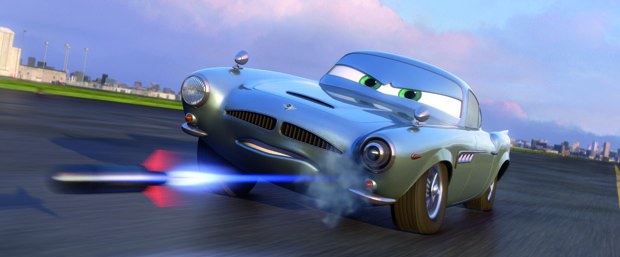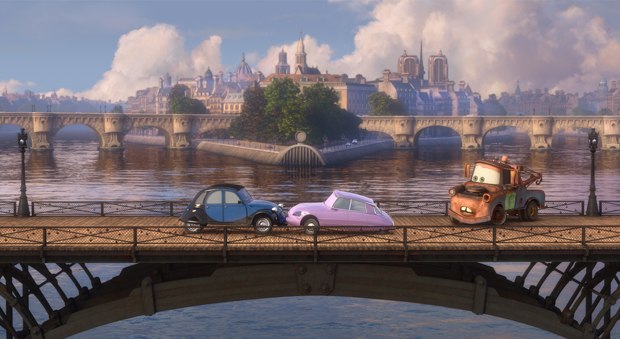The Pixar/Disney chief creative officer discusses his return to directing.
John Lasseter dismisses the notion that sequels are an easy way out. He points to The Godfather Part II and The Empire Strikes Back as examples of aiming higher and surpassing the original films. You could arguably throw in Toy Story 2 as well, and maybe even Cars 2 (opening June 24), which represents Pixar's first spy movie. It's been five years since Lasseter last directed Cars and he beamed about some of his favorite things.
Bill Desowitz: What's the Cars evolution been like for you?
John Lasseter: The idea for Cars came from a personal experience of me traveling across the country after spending the better part of the '90s making Toy Story, A Bug's Life and Toy Story 2, and having four of our five boys during that time. And my wife was saying, "You'd better be careful, one day you're going to wake up and your kids will have gone off to college and you're gonna miss it." And I learned that the journey in life is the reward and I came back and said that's what I want to be Cars to be about, and that's really the origins of that story.
And the origins of Cars 2 came from three places: One, during Cars, we developed a sequence, which was Sally and Lighting McQueen's first date. And we wanted to put it in the drive-in movie theater. So we thought, "What's playing on the screen?" And we actually got caught up, because we were having so much fun, in developing this spy movie starring this spy car called Finn McMissile [voiced by Michael Caine]. And so we had a lot of fun with that. The story shifted in Cars and took the first date from the movie theater to the cruising, and so that went away, but I never forgot the spy movie. And so after Cars came out, I was doing publicity all around the world and had Cars' characters on the brain. And, so every place I went, I kept looking out the window and found myself laughing and thinking, "What would Mater and Lighting McQueen be doing in these situations?" Like getting lost on the streets of Tokyo, which are so confusing. The huge roundabout around Arc de Triomphe in Paris. How anybody could try and maneuver through that would get stuck for days. Driving on the wrong side of the road on the Autobahn with no speed limit. In Italy, with all of those little scooters all around you like gnats. And so I thought that if I had the chance to do another Cars movie, I'd love to take them out of the United States and travel around the world, where there's so much opportunity.
And then there was the international press junket for Cars in Barcelona, connected with a Formula 1 race, the Spanish Grand Prix. And that's the first time I'd seen Formula 1 -- and it was like, wow! It was really impressive, cool and sexy. This was different from NASCAR, so I would love to get different types of cars and racing. That's how the origins of the World Grand Prix came from.
But the heart of the story is McQueen and Mater's friendship and how taking Mater out of Radiator Springs fractures their friendship because Mater can no longer be Mater wherever he goes, and he actually learns that people are no longer laughing with him but laughing at him. It's a very emotional, sweet part to it.
BD: You get to combine many passions here: cars, spy movies, animation, the love of Japan and other places. It's a very personal movie, isn't it?
JL: That's a great question because it's very reflective of how we make movies at Pixar. And the way it comes from your own life. And so Cars 2 is extremely personal for me. And we make the kinds of movies that we like to watch. And I'm a big kid. Look, I wear Hawaiian shirts all the time and you've seen my office. I discovered that I don't have to grow up, and I like to put that in movies, too. And I set out to make a film that was really fun from beginning to end and really different from Cars in action and setting and characters. And yet it still had the emotion, which is the hallmark of a Pixar film. And also there was a challenge to get as many different types of vehicles as characters in this movie because we have boats, we have airplanes, we have trains, we have helicopters. We even have a crane. And also what I wanted to do with Cars 2 was expand the world because the way I see the world of the characters is not contained in only what you saw in the first movie. It's really as big as our world. If you and I could both go someplace, then they could go to that place. But when they go to Paris, it's a "carified" Paris. And each one of them is like a true love letter to each of those places. For instance, I love Tokyo. And a lot of the scenes of them traveling is what I've experienced myself, especially the bathroom scene. If you've ever been to Japan and sat on one of those Japanese toilets for the first time, that is an experience.
BD: What was it like directing again?
JL: Stepping back into directing was really a joy. And for me it was fun because I love overseeing the studios being chief creative officer because I get to work with all these other filmmakers. But what's really fun about being a director is you get to work with the artists themselves and, for me, it's just getting back in touch with filmmaking that I love. And what's interesting that I found -- and I didn't expect this -- was how many new artists come along here at Pixar. Because there had been four movies made at Pixar since Cars. And so coming to work, half of the crew were people I hadn't worked with before. And they were unbelievably talented. Because I'm a very collaborative filmmaker, I love to put a lot things in the hands of the crew and see what they will come up with… things that I never would've thought of. But I also think being a filmmaker makes me a better executive. And so when I work with other filmmakers as chief creative officer, I come from a place of experience and know what they're going through and I can really help them. That includes first-time directors. When I first went to Disney and worked with Byron Howard and Chris Williams on Bolt, I helped them through each new phase of production, but mostly with story, and I helped raise the bar really high. "Aim high," I told them. And the same goes for here at Pixar.
Bill Desowitz is senior editor of AWN & VFXWorld.










